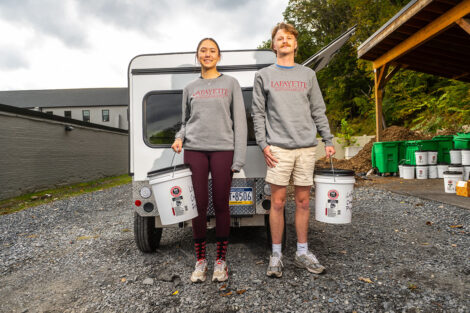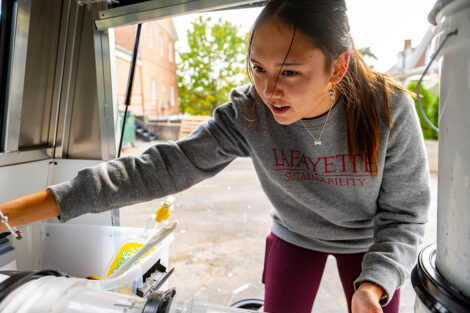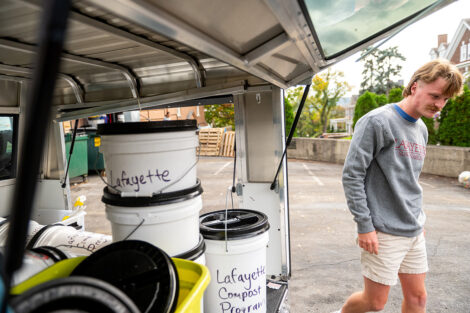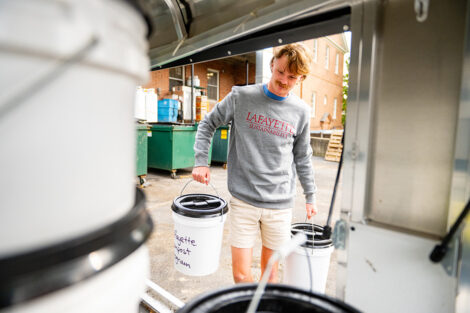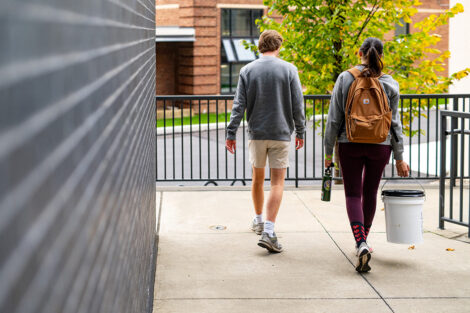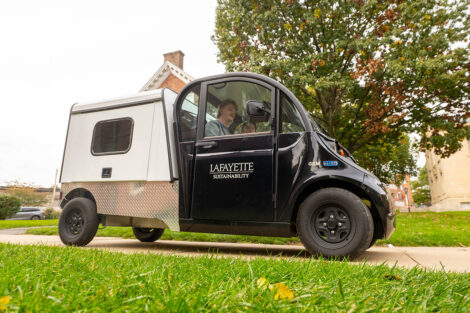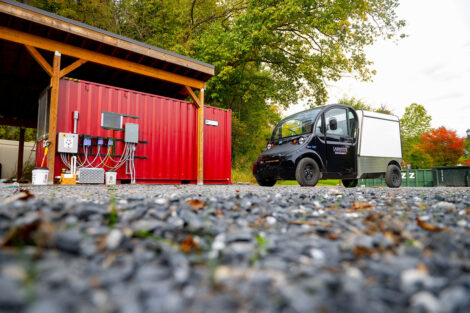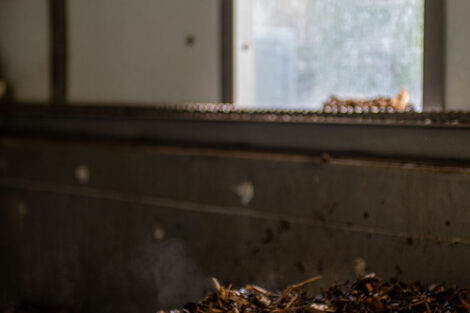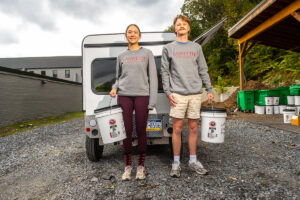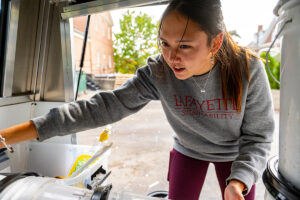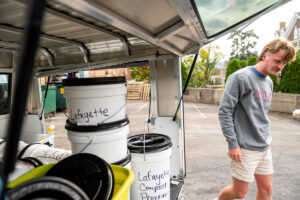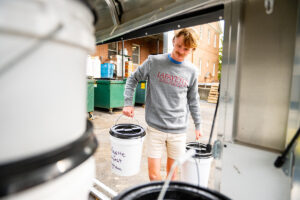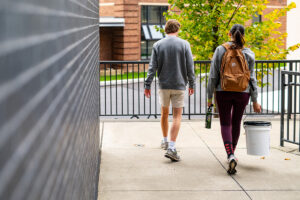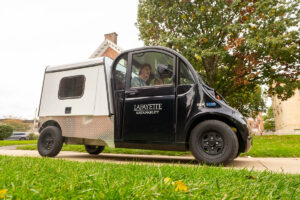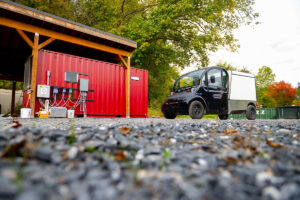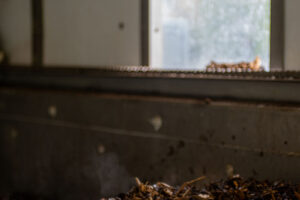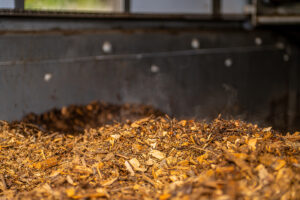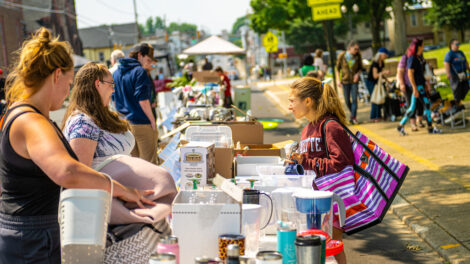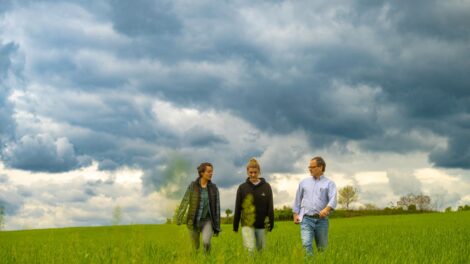Lafayette brings back campus-wide composting system to dining halls
By Madeline Marriott ’24
This fall, Lafayette reintroduced a campus-wide composting system to dining halls. Aided by a new composting vessel and students and staff from the Office of Sustainability, the program seeks to divert waste from the landfill and contribute to the sustainable food loop initiative.
“Composting shifts the way we think about organic waste as not a waste byproduct, but something that has use and continued useful life in a regenerative food loop system,” says Melissa Adamson, climate action and circularity manager.
Lafayette’s composting efforts involve the collection and transportation of food scraps from the dining halls. “What we do is combine that organic food waste with some brown waste materials such as wood chips or leaves, and together that mixture creates what we call compost, which is a soil-like substance,” Adamson says.
The program is staffed by a team of 10 Office of Sustainability student-interns. On any given day, two members of the team collect food scraps from both the kitchens (back of house) and the dish drop-off area (front of house) in Upper Farinon and Marquis dining halls in addition to any participants in the Sustainable Office Program who are on the list for that day. To accomplish this, the Office of Sustainability has partnered with dining services to ensure both employees and students can compost their scraps. The process also will accommodate for compostable materials from major College events, which used to be sent off-site to a third party vendor.
Interns then use the office’s electric vehicle to transport the buckets to the composting vessel located at 901 Bushkill Street.
“Inside the vessel, the main thing is this spinning, rotating auger that has teeth to chop up the food particles,” Adamson says. “It spins on an angle so that it brings things from the bottom up to the top, so it homogenizes the mixture and continues to help the aeration process.”
The day-to-day process is primarily a student-run endeavor. Pierson White ’24 is one of the 10 composting interns who collect and transport the material. Once at the vessel, White explains, there are a few more steps to their process. “We weigh the contents, take a temperature measurement of the bulk, and dump the contents of the buckets and an equal weight of either wood chips or landscape material into the vessel,” he says.
The weighing tells the team how much “brown waste” to add—and is used to track the College’s waste diversion rate—and the temperature check is a quality control measure to ensure the material is breaking down properly. Depending on the visual appearance of the contents, interns might also have to sift through the buckets to remove non-compostable items.
“The vessel operates on an automatic cycle,” Adamson explains. “Twice a day, it’ll run and mix all of the materials together, and after about three weeks of being in the vessel, the materials are turned into compost.”
White, who has worked on the Office of Sustainability’s metrics team in the past, was first drawn to the composting job because of its physical nature. “I’m a civil engineer, so I sit down and stare at computer screens all day, which is not great for my body or my eyes,” he says. “I also love the very tangible result of all of the hard work composting interns do—we yield literal compost that will be used at LaFarm.”
“My favorite part of the job is probably driving around with my co-workers picking up the compost material,” White adds. “It’s awesome to meet and talk to people I wouldn’t normally see. I have learned that composting is very practical and fairly straightforward, and can be done by anyone who has some space and facilities for it. It’s more of a life skill I can pick up.”
The effort is part of the Office of Sustainability’s sustainable food loop goal—produce is grown at LaFarm and used in the dining halls, and scraps from that food are then composted and reintegrated into the soil at LaFarm.
This program also contributes to the College’s waste diversion goals outlined in the Climate Action Plan: 40% waste diversion by 2030 and 60% by 2035.
One of White’s previous projects within the Office of Sustainability was a waste audit, collecting and characterizing the different types of waste being thrown out on campus. “A huge portion of what we found in the trash was compostable material, which is now being diverted away from landfills,” he says.
